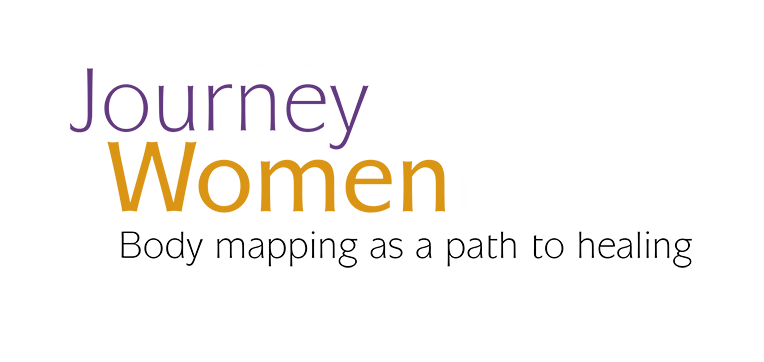
Journey Women is an ongoing project that aims to understand and support Indigenous women’s healing. The idea originated at Minwaashin Lodge, an Aboriginal support centre in Ottawa, Ontario, where eight women took part in a three-day arts-based workshop on their healing experiences. The artists shared their body map images and the stories of their healing journey in an art exhibit for Women Abuse Awareness Month at the Orange Gallery from November 10-14, 2010. Since then, presentations and artist talks have occurred at academic conferences, community centres and institutions, such as the Shingwauk Residential School Centre. The whole experience was transformed into a book entitled Journey Women: A Guide to Body Mapping as a Path to Healing (order form). This website is a continuation of this story-sharing and awareness-raising around the issue of violence against Indigenous women, and strives to celebrate their resilience and strength.

Journey Women came out of a collaborative research project between Minwaashin Lodge and Concordia University. Collaborators include art therapist Lucy Lu, Dr. Felice Yuen, an associate professor in the Department of Applied Human Sciences at Concordia, and eight Indigenous artists. The project has been guided by various Indigenous Elders, counsellors, and research advisors. The goal was to gain an understanding of the conditions that support and challenge Indigenous women in their process of healing from the impacts of violence.

Our body mapping process is based on Jane Solomon’s work Living with X: A Body Mapping Journey in the time of HIV and AIDS. The process was adapted for the exploration of Indigenous women's healing experiences, changing from a linear viewpoint to a circular life cycle to reflect Aboriginal life perspectives. The workshop incorporated traditional ceremonial elements like prayer, smudging, drumming and singing—all led by the artists—as well as movement activities, grounding exercises, poetry and art creation. This section, adapted from our book Journey Women: A Guide to Body Mapping as a Path to Healing (order form), is not meant to be a blueprint on how to create and facilitate a body mapping workshop, but rather a source of inspiration to encourage you to initiate your own.
In pairs, our project artists traced each other's body outlines to represent their current perception of themselves, then created a second outline to symbolize their support network—the people, agencies, events, spiritual supports and other resources that have given them strength. They used colours, symbols and textures to depict how they felt supported by these networks, depicting their pain as well as their healing. Both outlines were superimposed to show how each woman viewed her relationship to herself and her support network. Throughout the process, artists mapped out their journey towards healing, identifying with positive, affirming aspects of themselves and their culture, beyond the pain, hurt, abuse, violence and cultural assimilation they endured.
Collaboration in the body mapping process.
The women were asked to create symbols depicting different aspects of their life journey. Using a medicine wheel as inspiration, they then mapped out their origins, past challenges, current circumstances and hopes for the future, following the traditional life cycle from the right hand corner moving clockwise. They also marked the points of power on their bodies with a personal symbol, adding words and personal slogans that they felt gave meaning to their self-portrait and their journey. At each creative phase, women were encouraged to share their work to the extent they felt comfortable, with the option of using a pseudonym to protect their anonymity.
Personal symbols reflecting healing journeys.
Please click on the artist names to view their body map artwork and stories:
AMY
LYNDA
RAVEN
ROBERTA
NIKKUTAI
XOCHITL
LISA
SOPHIA


Journey Women: A Guide to Body Mapping as a Path to Healing (2016) explores the potential of body mapping as an arts-based approach to healing, based on the inspiring experiences of a group of Indigenous women artists and their interdisciplinary facilitation team. The book is designed to support researchers, educators and community leaders seeking to integrate body maps into their practices with marginalized populations, offering practical guidance, conceptual considerations and lessons learned to start their own creative journeys.
To obtain a copy of the book, please complete the order form.
Embodied Ways of Storying the Self: A Systematic Review of Body-Mapping by Adèle de Jager,
Anna Tewson, Bryn Ludlow and Katherine M. Boydel, offers a comprehensive review of body mapping in published literature. CLICK TO VIEW
WORKS STEMMING FROM THE JOURNEY WOMEN PROJECT
- Lu, L., & Yuen, F. (2012). "Journey Women: Art Therapy in a Decolonizing Framework of Practice." Arts in Psychotherapy: Special issue on Social Justice, 39(2), 192-200. CLICK TO VIEW
- Sjollema, S., & Yuen, F. (in press). "Poetic Representation: Reflexivity and the Recursive Turn." In M. Prendergast, C. Leggo, & P. Sameshima (eds.) Poetic Inquiry III: Enchantments of Place. Vernon, British Columbia: Vernon Press.
- Sjollema, S., & Yuen, F. (2016). "Evocative Words and Ethical Crafting: Poetic Representation in Leisure Research." Leisure Sciences. CLICK TO VIEW
- Yuen, F. (2016). "Collage: A Method of Analysis and Representation." Journal of Leisure Research, 48(4), 338-346. CLICK TO VIEW
To order a copy of Journey Women or to obtain more information, please contact us

ACKNOWLEDGEMENTS
Our deepest gratitude to our project collaborators, the talented Journey Women artists and Minwaashin Lodge. A very special thank you to Concordia University and the Fonds de Recherche du Québec – Société et culture for their generous funding.


